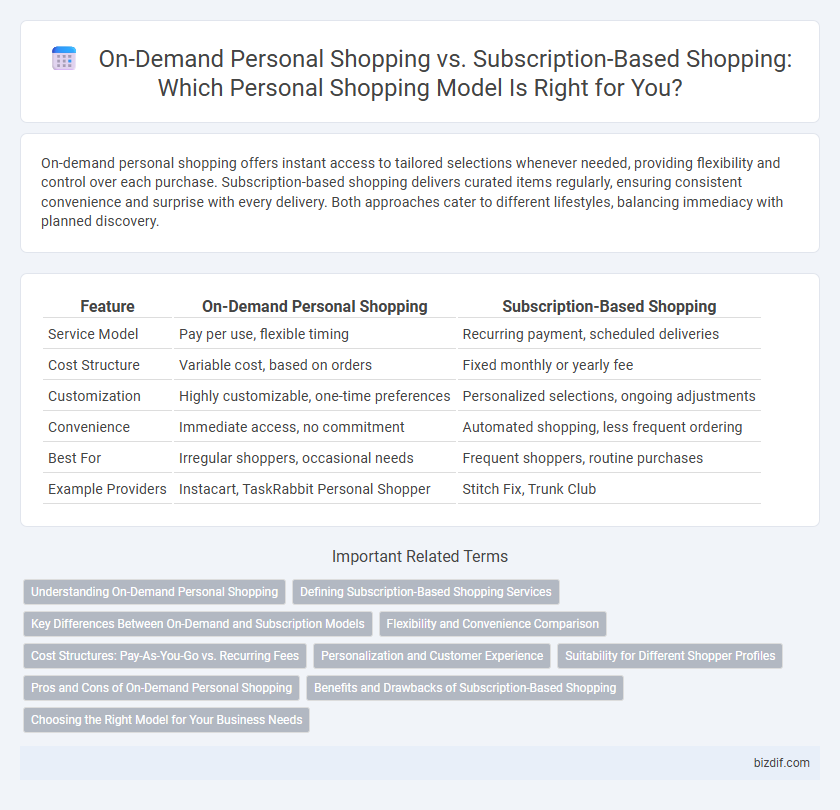On-demand personal shopping offers instant access to tailored selections whenever needed, providing flexibility and control over each purchase. Subscription-based shopping delivers curated items regularly, ensuring consistent convenience and surprise with every delivery. Both approaches cater to different lifestyles, balancing immediacy with planned discovery.
Table of Comparison
| Feature | On-Demand Personal Shopping | Subscription-Based Shopping |
|---|---|---|
| Service Model | Pay per use, flexible timing | Recurring payment, scheduled deliveries |
| Cost Structure | Variable cost, based on orders | Fixed monthly or yearly fee |
| Customization | Highly customizable, one-time preferences | Personalized selections, ongoing adjustments |
| Convenience | Immediate access, no commitment | Automated shopping, less frequent ordering |
| Best For | Irregular shoppers, occasional needs | Frequent shoppers, routine purchases |
| Example Providers | Instacart, TaskRabbit Personal Shopper | Stitch Fix, Trunk Club |
Understanding On-Demand Personal Shopping
On-demand personal shopping offers tailored assistance exactly when needed, providing flexibility and immediate access to professional shoppers without long-term commitments. This service enables users to request personalized recommendations, product sourcing, or styling help on a pay-per-use basis, ideal for occasional or urgent shopping needs. Understanding on-demand personal shopping highlights its convenience and customization compared to subscription-based models that require ongoing fees and scheduled deliveries.
Defining Subscription-Based Shopping Services
Subscription-based shopping services provide customers with regular, curated deliveries of products tailored to their preferences and lifestyle, often on a weekly or monthly basis. These services automate the purchasing process while offering convenience and personalization, drawing on data analytics and customer feedback to enhance item selection. Unlike on-demand personal shopping, subscription models emphasize consistency and ongoing engagement through scheduled shipments and exclusive member benefits.
Key Differences Between On-Demand and Subscription Models
On-demand personal shopping offers immediate, flexible access to products tailored to individual preferences without long-term commitment, while subscription-based shopping provides curated selections delivered regularly based on preset intervals. On-demand services emphasize convenience and real-time customization, often driven by AI algorithms and user inputs, contrasting with subscription models that rely on customer profiles and recurring shipments. The key differences lie in frequency, personalization depth, and customer control, with on-demand shopping maximizing spontaneity and subscription models ensuring consistency and discovery.
Flexibility and Convenience Comparison
On-demand personal shopping offers maximum flexibility by allowing customers to request items as needed without binding commitments, ideal for sporadic or urgent purchases. Subscription-based shopping provides ongoing convenience through curated selections delivered regularly, ensuring a steady supply of preferred products without frequent ordering. Personal shoppers tailor both models to individual preferences, balancing spontaneity with routine to optimize customer satisfaction.
Cost Structures: Pay-As-You-Go vs. Recurring Fees
On-demand personal shopping features a pay-as-you-go cost structure, allowing customers to pay only when they use the service, which provides flexibility and control over expenses. Subscription-based shopping requires recurring fees, typically monthly or annually, granting continuous access to personalized shopping services and often including exclusive perks or discounts. Consumers must weigh immediate cost savings against long-term value when choosing between these models.
Personalization and Customer Experience
On-demand personal shopping offers tailored experiences with immediate access to products based on real-time preferences, enhancing personalization and customer satisfaction through flexibility. Subscription-based shopping delivers curated selections regularly, fostering consistent engagement and personalized discovery while streamlining customer convenience. Both models leverage data-driven insights to optimize personalized recommendations and elevate the overall shopping experience.
Suitability for Different Shopper Profiles
On-demand personal shopping suits busy professionals seeking flexibility and immediate access to curated selections without long-term commitments, ideal for irregular shoppers. Subscription-based shopping benefits loyal customers who prefer consistent, personalized experiences and enjoy discovering new items regularly tailored to their style profiles. Both models cater to distinct shopper needs by balancing convenience, customization, and frequency of service.
Pros and Cons of On-Demand Personal Shopping
On-demand personal shopping offers flexibility and immediate access to tailored product selections without long-term commitments, making it ideal for sporadic or urgent needs. This model allows shoppers to receive personalized assistance only when required, which can reduce unnecessary expenses associated with subscription fees. However, the lack of continuous engagement may limit the shopper's exposure to ongoing personalized recommendations and exclusive deals typically offered by subscription-based services.
Benefits and Drawbacks of Subscription-Based Shopping
Subscription-based shopping offers convenience by delivering curated items regularly, saving time and often providing personalized selections tailored to individual preferences. However, it may lead to unwanted or unnecessary products, resulting in potential waste and higher overall costs compared to on-demand personal shopping. The fixed schedule can limit flexibility, making it less suitable for shoppers who prefer complete control over timing and item choice.
Choosing the Right Model for Your Business Needs
On-demand personal shopping offers flexibility and customization tailored to immediate customer preferences, ideal for businesses seeking to provide personalized experiences without long-term commitments. Subscription-based shopping, on the other hand, ensures consistent revenue and customer loyalty through regular, curated deliveries, benefiting brands focused on predictable growth and sustained engagement. Evaluating factors such as target audience behavior, operational capacity, and cash flow requirements is essential to choosing the right model for optimizing business performance.
On-demand personal shopping vs Subscription-based shopping Infographic

 bizdif.com
bizdif.com